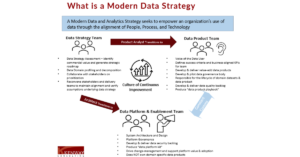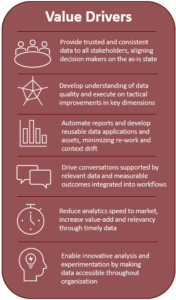Why Data Integration is Essential for Building a Data-Centric Organization

We’ve explored in our previous blog How to Achieve Seamless Data Integration– what Data Integration means, its benefits, and why it matters. Data integration is the cornerstone of building a data-driven organization. But once you get that stone in place, you must keep developing upon it to reap the rewards of being a true data-centric business.
Here we take data integration a step further and share how to make the leap from establishing your data architecture to weaving data integration throughout your culture, teams, and processes.
BRIDGING DATA INTEGRATION FROM ARCHITECTURE TO CULTURE
Let’s talk about soup. Campbell Soup has been around for 153 years, but its data integration practices are anything but old school. Campbell Soup reviews three hundred billion data points each year using its Insights Engine to track and curate trends. It uses these insights to inspire innovative new products and aid in product development.
The Insights Engine is powered by artificial intelligence and machine learning, but that doesn’t mean the data doesn’t interact with humans. The Campbell Soup team still needs to take the valuable data and use their brains to extract analysis related to things like shifts in eating habits, trends relevant to the business, or the potential for a new product. For example, when oat milk became popular, Campbell Soup used AI and predictive analysis to determine when oats would make their way into soups, sauces, bakery items, and confections and timed the launch of its oat milk soup accordingly.
Campbell Soup has transformed into a company driven by innovation and anchored by a data-driven culture. Organizations like Campbell that empower their people to understand the data trends such as the market, geography, or demographics will have a better handle on how to leverage these trends from a historical perspective, the state of the situation right now, and where trends might be going. Just like the oats, they can use the data to identify where they’ve been and where they want to go next.
HOW TO DEVELOP THE RIGHT TEAMS TO INTEGRATE DATA CULTURALLY IN AN ORGANIZATION
A challenge we often hear from clients is that they may realize the benefits of integrating data culturally but often need help with a familiar roadblock: skill sets.
Organizations frequently need help aligning their teams with their data integration needs because the skill sets of teams are changing. Think about it … yesterday’s analyst Excel wizard is not as relevant in today’s world of cloud computing and data warehouses. They must learn new competencies and skills such as data engineering, networking and security, and UX to remain competitive.
The management, integration, virtualization, and distribution of comprehensive data in the cloud are the competencies that product leaders and engineers must master in the current phase of digital transformation. These skill sets will likely be quickly augmented and amplified by the application of model-based services over the next ten years based on the state of AI and ML progress.
This scenario means your teams will no longer need to do their own forecasting. They can leverage a model to do it for your business, but only if they have the necessary skills and the quality data to feed it.
WHY YOU NEED ANALYST 2.0 AND PRODUCT LEADER ON YOUR TEAM
So, what is driving this emphasis on skill sets? One reason could be the rise of DataOps. Industry-wide, we are seeing a maturation of DataOps that is propelling the delivery of data and the acceleration of analytics that the business can effectively use. The discipline of DataOps emphasizes “communication, collaboration, integration, automation, and measurement of cooperation between data engineers, data scientists, and other data professionals.”
Let’s break that down to what DataOps means for your team. Think of building your teams to encompass two archetypes that can respond in a nimble and agile way to a rapidly changing technology business and economic landscape.
You have Analyst 2.0, a cross-functional generalist who shows aptitude to pick up technical skills. You also have the Product Leader who is curious about solving problems, good at learning, and cares deeply about their domain. Keep in mind that product leadership is a critical aspect of product ownership, but the attributes of product leadership are vital to making the role successful.
Analyst 2.0 and Product Leader roles can be the same person or multiple team members, but the key is that they need to wear those two hats. And they all must possess the ultimate tool in their skill set toolbox: communication. It is essential that team members, from technologists to engineers, be able to convey information in order to drive data throughout the culture of an organization.
WHAT IS THE MODERN DATA STRATEGY?
Andy Grove, the former chairman and chief executive officer of Intel is quoted as saying,
“To understand a company’s strategy, look at what they actually do rather than what they say they will do.” – Christensen, Clayton M., et al. How Will You Measure Your Life? Harper Business, 2012, p. 71.
The Modern Data Strategy is not a document, it is a journey that requires time and investment in people, processes, and technology, all aimed at the correct objectives. Or rather, as experience has taught us, the ability to consistently correct your aim as new data and information is uncovered on this journey. A Modern Data and Analytics Strategy seeks to empower an organization’s use of data by aligning people, processes, and technology. The value drivers ensure alignment across the organization.
Organization Value Drivers for Modern Data Strategy:
How to Build a Data Culture from the Inside Out
At Kenway Consulting, we often see clients in the mindset of ‘if you don’t know what you’re looking for, you’re not going to find what you need.’ They struggle to understand how to maximize the investment and the value of data and how to integrate the data within the business.
If this sounds familiar, Kenway can help your organization break through the inertia and define what you need by adopting an agile approach to digital transformation. Connect with us to learn more about the Modern Data Strategy.









